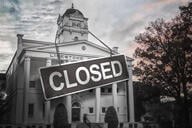You have /5 articles left.
Sign up for a free account or log in.
The debt ratings of all but five of the more than 220 private colleges and universities tracked by Standard & Poor’s stayed the same or improved during the 2006 fiscal year, the financial ratings service reported Tuesday.
Offering a largely upbeat assessment, Lori Torrey, primary credit analyst, said the ratings were bolstered by the double-digit endowment returns that many institutions experienced for the second consecutive year, as well as record-high levels of fund raising and demand from students in 2006. Trends for the first half of 2007 suggest a stable or positive outlook for 96 percent of the institutions in the ratings, Standard & Poor's said.
The strong economic performance of most colleges and universities in 2006 continued to balance out the debts that many institutions encountered during the last five years while building and renovating on their campuses and pursuing other expensive initiatives.
The Standard & Poor’s report, “Fiscal 2006 Ratios for U.S. Private Colleges and Universities,” assigns ratios ranging from a high of AAA to BB based on a variety of financial and academic statistics, including investment and endowment income, debts, operations expenditures, freshman matriculation rates and average SAT scores of entering freshmen.
The highest-ranked AAA institutions include five of the eight members of the Ivy League as well as top liberal arts colleges like Amherst College and major research universities such as the Massachusetts Institute of Technology.
Ratios fell for five institutions in the 2006 rankings, largely based on high levels of endowment spending, declining or fluctuating enrollments and new debts. Trinity College, in Connecticut; Rensselaer Polytechnic Institute, in New York; Hollins University and Regent University, both in Virginia; and Vaughn College of Aeronautics and Technology, in New York, all had their ratios lowered.
Nine other institutions’ ratings were improved, including Trinity University, in Texas, which improved to AA from AA-, and Ohio's Kenyon College. which improved to A+ from A.
Mary Peloquin-Dodd, secondary credit analyst on the report, expressed concern about the rising costs of “providing educations” and the “inability of a lot of people to afford the high sticker price” of higher education at public or private institutions, two invariably linked factors.
While some colleges and universities have maintained rates of “conservative endowment spending,” said Josh Stern, a credit analyst, others are upping the percentages of annual endowment income that they spend in order to minimize increases in student tuition and fees. “We’re seeing endowment spending policies go up at some institutions and down at others,” he said, though it’s unclear whether it’s best to focus on spending for the current generation of students or saving for the future.
The analysts were encouraged by the strength of fund raising and donations at many private colleges and universities.
Several institutions on the list approached completion of billion dollar capital campaigns during the last year, while others kicked off major campaigns. Columbia, Cornell and Stanford Universities all began campaigns with fund raising goals of at least $4 billion by 2011. Those universities and others are increasingly receiving larger donations from individual donors, the report said.
Fitch Ratings and Moody’s Investors Service also releases debt ratings on institutions of higher education.




